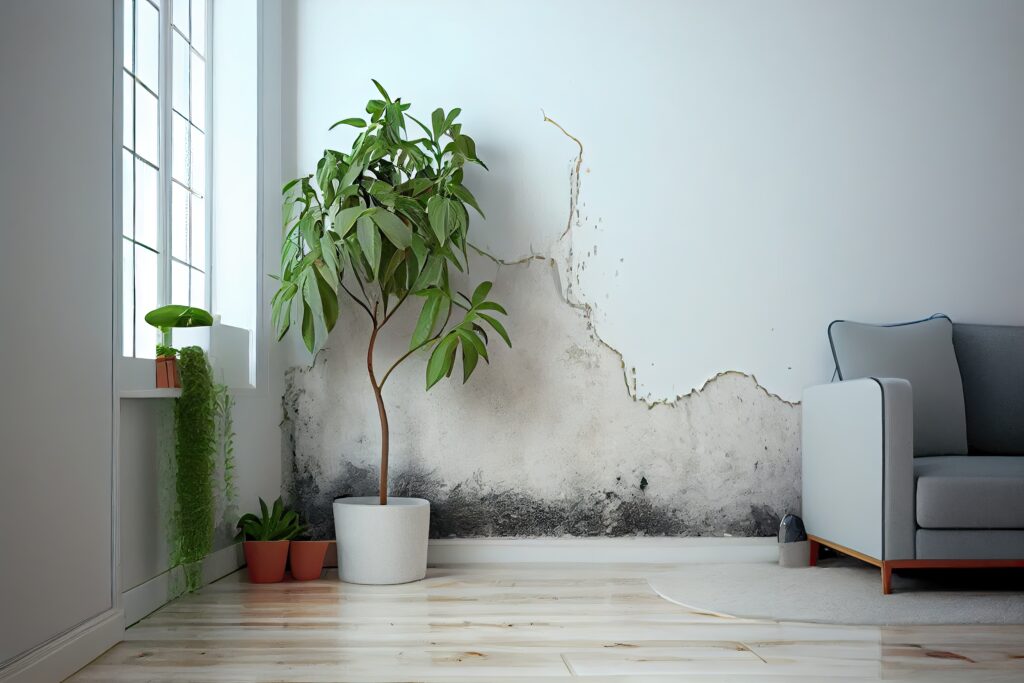Damp can present an array of issues for any property, from minor irritations to significant structural problems. Understanding the types of damp that can affect a property, the signs to look for and the appropriate remedies can make a big difference. In this guide we will delve into the most common types of damp, their causes, and how to combat them effectively.

Identifying the Types of Damp
There are three primary types of damp: condensation, rising damp, and penetrating damp. Recognising each type is essential for dealing with it appropriately.
Condensation occurs when warm air, laden with moisture, comes into contact with a cold surface, causing the moisture to condense. Common in bathrooms and kitchens, it can lead to black mould, peeling wallpaper, and water on windows.
Rising Damp affects the lower areas of walls and floors. It’s caused by groundwater being sucked up through the fabric of a building, usually due to a failing or non-existent damp proof course (DPC). Signs include a ‘tide mark’ of dampness, peeling paint or wallpaper, and salt deposits on walls.
Penetrating Damp is caused by water seeping through the walls, often because of structural issues like leaking gutters, cracks in the brickwork, or compromised roof tiles. Its signs are similar to rising damp, but it can occur anywhere on walls or ceilings.
How to Deal with Condensation
Condensation is the most common form of dampness, often exacerbated in colder months. Simple lifestyle changes can alleviate this issue. Regular ventilation, especially in moisture-heavy rooms like kitchens or bathrooms, is crucial. Double glazing can help prevent condensation on windows, and dehumidifiers can effectively reduce the moisture level in your home.
Installing extractor fans in bathrooms and kitchens will drastically reduce the amount of moisture present in the air. Additionally, maintaining a consistent heat within your home can stop condensation from forming.
Combatting Rising Damp
Rising damp requires professional attention, typically involving the installation or repair of a damp proof course (DPC). The severity of the damp will dictate the complexity of the solution. In minor cases, injecting a chemical DPC into the affected wall might be sufficient. However, more severe cases could require the replacement of decayed plaster or even extensive brickwork.
Preventive measures, like good exterior maintenance, can help minimise the risk of rising damp. Regular checks of your external brickwork and immediate repair of any damage are essential.
Solving Penetrating Damp
Addressing penetrating damp involves identifying and repairing the structural issues allowing water ingress. This could include fixing damaged roofing, repairing or replacing defective window frames or doors, re-pointing brickwork, or clearing and repairing gutters and downpipes. If left unattended, these issues can allow water to penetrate, leading to damp.
After the cause has been fixed, the internal damage needs to be addressed. This often involves replacing damaged plaster and repainting or re-wallpapering. A professional survey is often the best way to identify the full extent of the problem.
Fixing damp in your home or property may seem daunting, but with early detection and the right approach, it can be effectively dealt with. While you can manage some issues, especially the condensation form of damp yourself, don’t hesitate to seek professional advice when dealing with more severe damp problems.
Please remember that any alterations to your home, particularly those involving its structure, should be carried out by a professional. A damp proofing expert can assess your property accurately and ensure the correct work is carried out to a high standard. DIY solutions can often exacerbate the problem if they are not done correctly.
Damp can lead to serious problems if left untreated, including structural damage to your property and potential health issues for you and your family. So, don’t delay – tackle your damp problems head-on today for a safer, healthier home.






